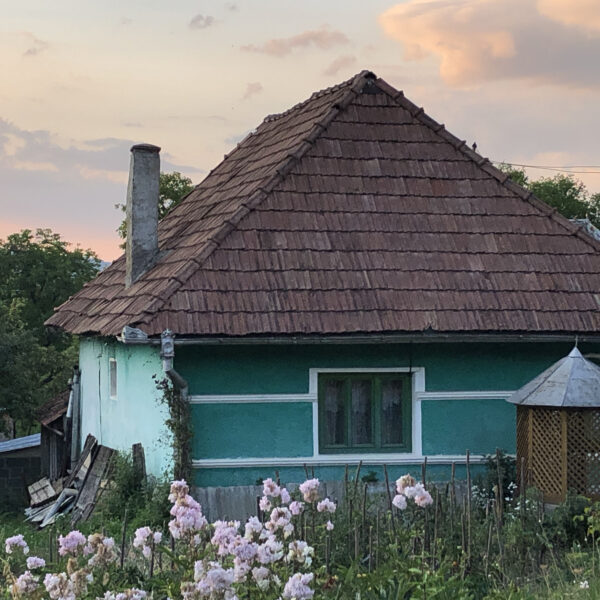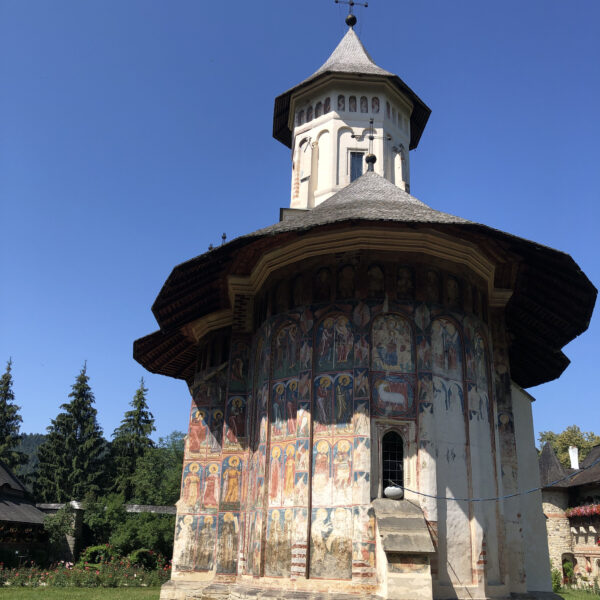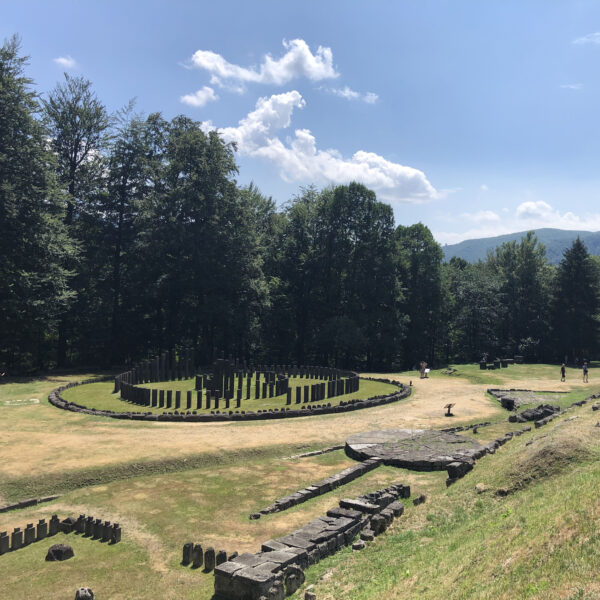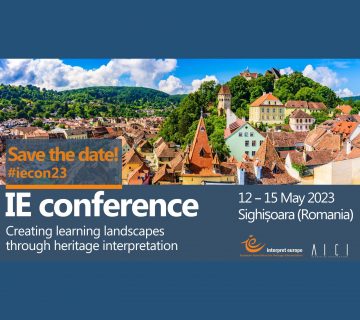Ahead of iecon23 some memories of a trip through Romania last summer, to give you a little taster of its rich history and cultural heritage.
The English have a lovely expression for my kind of trip, a “busman’s holiday”. And I am sure it sounds all too familiar: when visiting a park, a castle, a historic site, a museum abroad or at home, you immediately start looking at how the text is written, how the panels are fixed to the ground, how the interactives work (and if there are any, and why/why not?!), what is the underlying design approach… You wonder about the key messages, stories, themes. What target audiences might they have had in mind, what are the accompanying materials, does the visitor route work?
Sometimes it is hard for us to shed the professional perspective, to let go and abandon ourselves wholeheartedly to the experience, the history, the landscape. To become a real visitor, or better still: traveller, and to forget about work and interpretive principles. But when you are able to do just that, it is probably the best sign that something is at work: subtle, nudging, surprising, exciting, touching, and thus supporting the personal journey of discovery, even revelation.
The first time we set sight on one of the famous painted churches of the Bukovina, a region in the Northeast of Romania, was at the end of a long hot day travelling up from the Danube Delta. We entered the churchyard at Manastirea Voronets and stopped dead in our tracks. This monastery with its central church it is a wonder to behold, covered outside and in with vivid paintings glowing in the light of the late afternoon sun. I know this probably all sounds a bit kitsch, but there is something incredibly immediate and touching and almost spiritual experiencing those churches in the real for the first time. You can get a brief taster from this video in which we tried to capture a little of the beauty: https://www.instagram.com/reel/CgSSZbLI8On/?igshid=YmMyMTA2M2Y=
Soon we came to notice the shared architecture and iconography between the churches in the region and also their subtle differences, enhanced in each case by their individual settings. Their uniqueness lies not just in their survival as architectural and art historical gems, but also in their ongoing use as places of worship and as spiritual centres for the surrounding communities, i.e. as pieces of living heritage. Which also sets them in the context of the often-troubled history of the wider region, from the middle ages, and the assaults from the Ottoman Empire, to the events of the 20th century.
In the last of ‘our’ churches, in Pătrăuţi we met what must be the one of the coolest nuns in the world. The site was closed when we arrived, but speaking to some passers-by – they were domestic tourists, Siebenbürgen Saxons, from down South and spoke in their ancient German dialect, in itself another fascinating chapter of Romanian history – we found out that she lived across the road and looked after the site. She offered us our very own, private tour of the tiny church. Noticing we didn’t speak Romanian, she took out her smartphone, talked into it and her explanations were directly translated back to us, even responding to our questions. It was a unique example of coexistence, survival, mutual benefit … and so much more and hard to put into words: a coming together of medieval art, of ancient spirituality, a sense of place and modern technology, lived in and delivered by this particular person. A truly personal experience.
One of the most enchanted places in the country, to borrow from William Blacker’s book about his stay in the region, has to be the Maramures. It is a landscape of almost heartbreaking beauty, especially in summer when it is all meadows, rolling hills, the air heavy with the scent of wild herbs, and vast oak and beech forests full of blueberries, sold by the punnet by old ladies along the roadside. The village of Breb is almost like living within a heritage site; ancient houses covered with wooden shingles, dirt tracks leading through the village with horse-drawn carts rumbling along, orchards heavy with fruit, every homestead guarded by an enormous dog on a chain – and little did we know when we first booked our accommodation here that this was exactly the village where the author of ‘Along the enchanted way’ had lived in the late 1990s. Much has changed since then, no doubt, but still it seemed to us like a step far back in time.
An unusual experience on our way southwards towards the Retezat mountains, was the salt mine at Turda, in use since the middle ages, its heyday under Austrian rule: it felt like a mix between the mines of Moria and one of the settlements on the outer rings of the solar system in “The Expanse”. Considering its attraction for domestic visitors and to avoid long queues it is best to use the old side entrance. This leads you along a long tunnel into the mine and into a vast network of tunnels that run deeper and deeper inside the lodes of rock salt, the walls patterned and shimmering like polished marble. The shafts that drop downwards into the main halls are immense, some over 100 metres deep and more than 60 metres across, and down in the distance you can spot a lake with little boats bobbing on its surface. In the various rooms there are panels and displays of old machinery and tools, relics of a pre-industrial age. Using either stairs or lifts you end up on the floor of the mine, slightly incongruously filled with cafes, restaurants, playgrounds and a fun fair, neon lights flashing, music blasting – the effect like being caught in a sci-fi film by Ridley Scott. What was meant as a short stopover ended up as a several hour stay.
Corvin’s Castle in Hunodoara was a contrast and surprisingly under-interpreted, considering its place in Romanian history: this was the castle of the house of Hunyadi, which – with Matthias Corvin as its most famous protagonist – played an enormous role in the history of central Europe during the Renaissance. There were signs outside of an EU-sponsored project, and the hope is that something will be done about this fairytale castle, which in its current shape and form is mostly a 19th-century take on the middle ages.
The Retezat mountains, one of many of Romania’s national parks, with their untamed primordial forests are a paradise for ‘wild walkers’, bird watchers and nature lovers – and an example of that other side of Romania that will surprise Western visitors. Used to the more sedate nature experiences of say, the Cairngorms, the Carpathian mountains or the Alps, they are rugged and undeveloped, their fauna and flora wild, rich and surprising. There are only few corners like this that survive in Europe: the Rhodope mountains in Bulgaria, the Albanian ‘Accursed Mountains’ and maybe parts of the Pindus.
It is about one hour’s drive – 1.5 if you get lost on the way like we did – from there to Sarmizegetusa, the ancient religious and military centre of the Dacians, and razed to the ground by the Romans in the early 100s AD in that campaign that is described in some detail on Trajan’s column in Rome. The journey to the site takes a bit of commitment and follows a long and winding valley through a densely forested area, distant from any major modern settlement. Its destruction was so effective that for over 1,500 years it lay undiscovered, one of the many places and sites mentioned in old manuscripts and half consigned to historical myth. It also touches on a highly sensitive part of Romanian historiography, namely the relationship of modern Romania with its ancient history, or rather: the question of a (supposed) continuity between its Roman settlement and its ancient population, through the middle and early modern ages to the modern state. From the 19th century onwards this became a highly contentious issue, which also defined Romania’s relationship with its neighbours, Hungary and Bulgaria in particular. The echoes of which can be traced in ongoing academic debates that still have political resonance and can spill over into the public domain.
All that aside, Sarmizegetusa today is an idyllic place, surrounded by deciduous forest, laid out over several terraces on a hill spur that overlooks an ancient river valley. On the plateaus stretch the remains of defensive walls, of public buildings and temples. The site feels carefully chosen, for its location and how everything is arranged. Nothing much is known about the Dacians, their history, their religion, their society, rulers, military or societal organisation but the remains here – and what is kept in the national and international collections – have their very own, specific flavour and follow none of the classic layouts so familiar and prevalent in Europe from the Greek or Roman world. Not unsurprisingly, some of their artworks show a relationship to the art of the Scythians and Thracians further south and along the Black Sea. In any case, Sarmizegetusa is evidence of a sophisticated culture with a high level of organisation and social structure. You can see a short video clip of the site here: https://www.instagram.com/reel/CgpYz7OIISX/?igshid=YmMyMTA2M2Y=
The old Dacian capital was the last stage on our “busman’s trip” that had started, two weeks before, in the Danube Delta. The mouth of this truly European river is probably the nearest our continent has to Huckleberry Finn and Tom Sawyer country. Full of canals and streams, dead water pools, and reed swamps it is teeming with wildlife, holds the remains of an ancient settlement and of a failed tourist project by its erstwhile dictator. Some of its current villages can only be reached by boat on an hour-long journey – you park your car and leave from a derelict pier on the outskirts of Mahmudia (its name another reminder of the country’s history of changing influences). Their population is a mix of people of Ukranian, old-Russian, Turkish and Romanian descent; and when you stand on the edge of the land, on the shore that links the river estuary to the sea, in the distance you can glimpse ship convoys passing, moving slowly, so the locals told us, northward towards Ukraine.
Dirk Bennett is the Exhibition Development Manager for Tower Bridge and The Monument in London, UK. Originally from Germany, he has been in the UK since 1994. He holds an MA in history and archaeology and has worked in the cultural sector for private and public bodies. He writes extensively for publications in the UK and Germany as a freelance author and cultural correspondent. He can be contacted at: dirk.bennett@cityoflondon.gov.uk.
To cite this article: Bennett, Dirk (2023) ‘Around Romania in two weeks’ in Interpret Europe Newsletter 1-2023, pg. 4-6.
Available online: https://interpret-europe.net/wp-content/uploads/2023/03/PDF-Newsletter-2023_1-spring.pdf




